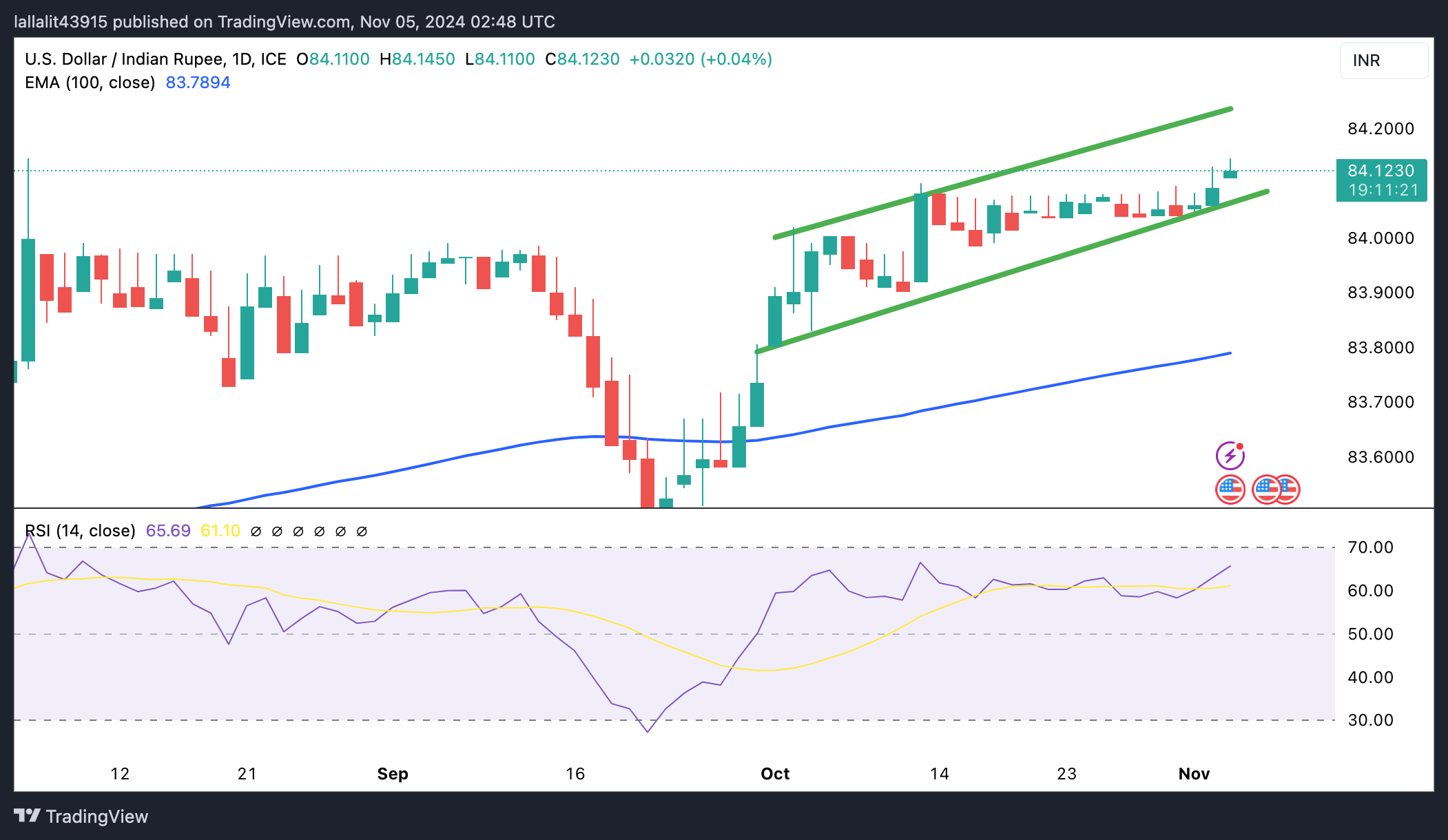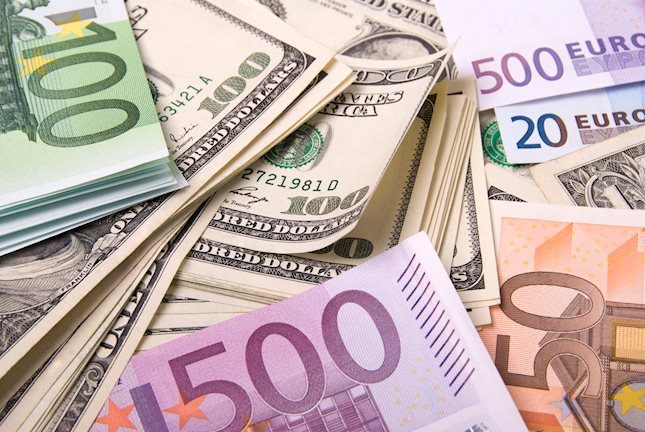- The Indian Rupee extends the decline in Tuesday’s early European session.
- Negative domestic markets and relentless foreign capital outflows weigh on the INR.
- Investors await the outcome of the US presidential election for fresh catalysts.
The Indian Rupee (INR) extends its downside on Tuesday after closing at a new all-time low in the previous session. The downtick movement of the local currency is pressured by continuous foreign outflows from the equity markets due to jitters amid institutional players ahead of the outcome of the US presidential election and the US Federal Reserve (Fed) interest rate decision on Thursday.
Nonetheless, the likely foreign exchange intervention from the Reserve Bank of India (RBI) by selling US Dollar (USD) could help limit the INR’s losses. Looking ahead, investors brace for the winner of the US presidential election, which may not be known for days after voting ends. On Thursday, the Fed monetary policy meeting will be closely watched.
Daily Digest Market Movers: Indian Rupee remains vulnerable amid US election-related uncertainty
- The HSBC final India Manufacturing Purchasing Managers Index (PMI) improved to 57.5 in October from an eight-month low of 56.5 in September and was above a preliminary estimate of 57.4.
- "India's headline manufacturing PMI picked up substantially in October as the economy's operating conditions continue to broadly improve," noted Pranjul Bhandari, chief India economist at HSBC.
- "The polls suggesting that Harris may have her nose in front in a couple of swing states is causing a bit of profit-taking in the Trump trade,” noted Kenneth Broux, head of corporate research FX and rates at Societe Generale.
- According to the IMF, India is now estimated to overtake Japan as the world's fourth-biggest economy by FY2025. The IMF forecasts that India's GDP will rise to $4,340 billion next fiscal year.
- Financial markets are now pricing in nearly a 98% possibility of a quarter point reduction and a near 80% chance of a similar-sized move in December, according to CME's FedWatch tool.
Technical Analysis: USD/INR keeps the positive outlook
The Indian Rupee softens on the day. According to the daily chart, the constructive outlook of the USD/INR pair remains unchanged as the pair is well-supported above the key 100-day Exponential Moving Average (EMA). The 14-day Relative Strength Index (RSI) holds above the midline near 65.20, indicating that further upside looks favorable.
The upper boundary of the ascending trend channel of 84.25 acts as an immediate resistance level for USD/INR. A clear bullish candlestick above this level could pave the way to 84.50, en route to the 85.00 psychological level.
On the flip side, a breach of the lower limit of the trend channel near 84.05 could attract enough bearish pressure to 83.78, the 100-day EMA.

RBI FAQs
The role of the Reserve Bank of India (RBI), in its own words, is "..to maintain price stability while keeping in mind the objective of growth.” This involves maintaining the inflation rate at a stable 4% level primarily using the tool of interest rates. The RBI also maintains the exchange rate at a level that will not cause excess volatility and problems for exporters and importers, since India’s economy is heavily reliant on foreign trade, especially Oil.
The RBI formally meets at six bi-monthly meetings a year to discuss its monetary policy and, if necessary, adjust interest rates. When inflation is too high (above its 4% target), the RBI will normally raise interest rates to deter borrowing and spending, which can support the Rupee (INR). If inflation falls too far below target, the RBI might cut rates to encourage more lending, which can be negative for INR.
Due to the importance of trade to the economy, the Reserve Bank of India (RBI) actively intervenes in FX markets to maintain the exchange rate within a limited range. It does this to ensure Indian importers and exporters are not exposed to unnecessary currency risk during periods of FX volatility. The RBI buys and sells Rupees in the spot market at key levels, and uses derivatives to hedge its positions.
India has run a trade deficit for most of its recent history, indicating its imports outweigh its exports. Since the majority of international trade takes place in US Dollars, there are times – due to seasonal demand or order glut – where the high volume of imports leads to significant US Dollar- demand. During these periods the Rupee can weaken as it is heavily sold to meet the demand for Dollars. When markets experience increased volatility, the demand for US Dollars can also shoot up with a similarly negative effect on the Rupee.
Higher inflation, particularly, if it is comparatively higher than India’s peers, is generally negative for the currency as it reflects devaluation through oversupply. Inflation also increases the cost of exports, leading to more Rupees being sold to purchase foreign imports, which is Rupee-negative. At the same time, higher inflation usually leads to the Reserve Bank of India (RBI) raising interest rates and this can be positive for the Rupee, due to increased demand from international investors. The opposite effect is true of lower inflation.
Information on these pages contains forward-looking statements that involve risks and uncertainties. Markets and instruments profiled on this page are for informational purposes only and should not in any way come across as a recommendation to buy or sell in these assets. You should do your own thorough research before making any investment decisions. FXStreet does not in any way guarantee that this information is free from mistakes, errors, or material misstatements. It also does not guarantee that this information is of a timely nature. Investing in Open Markets involves a great deal of risk, including the loss of all or a portion of your investment, as well as emotional distress. All risks, losses and costs associated with investing, including total loss of principal, are your responsibility. The views and opinions expressed in this article are those of the authors and do not necessarily reflect the official policy or position of FXStreet nor its advertisers. The author will not be held responsible for information that is found at the end of links posted on this page.
If not otherwise explicitly mentioned in the body of the article, at the time of writing, the author has no position in any stock mentioned in this article and no business relationship with any company mentioned. The author has not received compensation for writing this article, other than from FXStreet.
FXStreet and the author do not provide personalized recommendations. The author makes no representations as to the accuracy, completeness, or suitability of this information. FXStreet and the author will not be liable for any errors, omissions or any losses, injuries or damages arising from this information and its display or use. Errors and omissions excepted.
The author and FXStreet are not registered investment advisors and nothing in this article is intended to be investment advice.
Recommended content
Editors’ Picks

EUR/USD clings to daily gains near 1.0300 after US PMI data
EUR/USD trades in positive territory at around 1.0300 on Friday. The pair breathes a sigh of relief as the US Dollar rally stalls, even as markets stay cautious amid geopolitical risks and Trump's tariff plans. US ISM PMI improved to 49.3 in December, beating expectations.

GBP/USD holds around 1.2400 as the mood improves
GBP/USD preserves its recovery momentum and trades around 1.2400 in the American session on Friday. A broad pullback in the US Dollar allows the pair to find some respite after losing over 1% on Thursday. A better mood limits US Dollar gains.

Gold retreats below $2,650 in quiet end to the week
Gold shed some ground on Friday after rising more than 1% on Thursday. The benchmark 10-year US Treasury bond yield trimmed pre-opening losses and stands at around 4.57%, undermining demand for the bright metal. Market players await next week's first-tier data.

Stellar bulls aim for double-digit rally ahead
Stellar extends its gains, trading above $0.45 on Friday after rallying more than 32% this week. On-chain data indicates further rally as XLM’s Open Interest and Total Value Locked rise. Additionally, the technical outlook suggests a rally continuation projection of further 40% gains.

Week ahead – US NFP to test the markets, Eurozone CPI data also in focus
King Dollar flexes its muscles ahead of Friday’s NFP. Eurozone flash CPI numbers awaited as euro bleeds. Canada’s jobs data to impact bets of a January BoC cut. Australia’s CPI and Japan’s wages also on tap.

Best Forex Brokers with Low Spreads
VERIFIED Low spreads are crucial for reducing trading costs. Explore top Forex brokers offering competitive spreads and high leverage. Compare options for EUR/USD, GBP/USD, USD/JPY, and Gold.